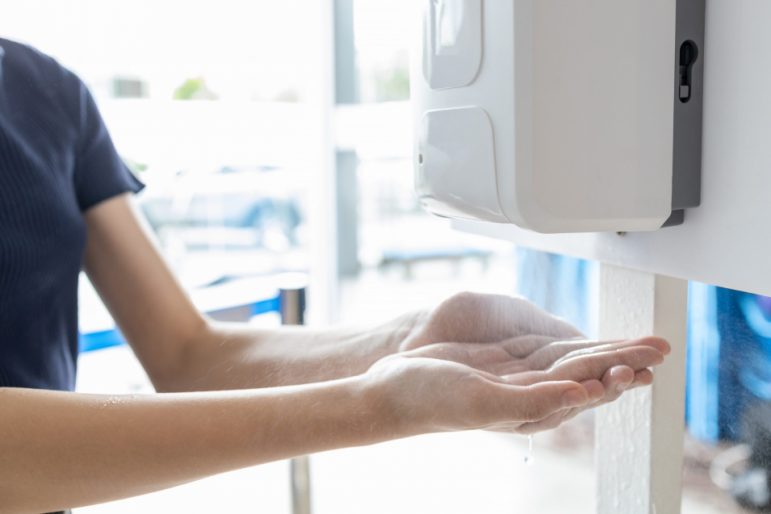The World Health Organization (WHO) has long recommended its five moments of point-of-care hand hygiene as a way to reduce the incidence of cross-contamination in healthcare settings. On paper, these moments are logical, obvious, even basic and elementary.
Yet the WHO’s own data shows that, on average, fewer than 40 per cent of healthcare workers follow hand hygiene best practices.
With hospitals, medical clinics, senior living facilities, and virtually every kind of healthcare facility spending a substantial amount of time and money to help workers comply with infection prevention best practices, why does compliance remain consistently low?
Through proprietary research, GP PRO learned that healthcare workers face a number of barriers to proper hand hygiene, including emergencies that require immediate attention; a busy workload; malfunctioning, broken, or empty hand sanitizer dispensers; full hands; and difficulty during the glove-on and glove-off process.
RELATED: Inconvenience largely to blame for lack of hand hygiene
Understanding that many of these inconveniences are due to the very nature of the work clinicians do, here are three recommendations to help advance hand hygiene among healthcare workers:
Seek input from clinicians
For some, the very idea of hand hygiene compliance and monitoring evokes George Orwell’s Big Brother. This is exacerbated when policies and protocols are developed without input from the very people who are expected to follow them, and is exacerbated further when they are developed by someone whose responsibilities do not include day-to-day patient care.
Doctors, nurses, orderlies, care assistants, and other clinicians can readily identify the challenges that keep them from performing proper hand hygiene all the time. Those reasons are likely to include the barriers identified in the research as well as many others, such as skin sensitivity, a perception that cleaning hands isn’t necessary if gloves are worn, a sense of overconfidence, frequent entry and exit, or a lack of motivation realized through rewards and consequences.
This staff perspective is necessary to help providers feel they are part of the infection prevention solution and not just the problem, and it is invaluable for developing a methodical and multi-faceted program that is set up for success. If, for example, a high percentage of clinicians identify their hands being full as a reason for not sanitizing, this can be addressed by reviewing workflow procedures and making small, easily implemented changes that help ensure items get where they need to go without compromising safety.
Walk in clinicians’ footsteps
The physical placement and location of sanitizer dispensers as well as their proper monitoring and maintenance is another critical component of an effective infection prevention program. Frequently, sanitizer dispensers are placed at the entrance to a patient’s room and beside an in-room sink. These placements are perfectly appropriate some and perhaps most of the time.
But if a healthcare provider’s hands are full when entering the room, if their first stop is at a bedside table, or if a patient is experiencing an emergency, those dispenser locations become inconvenient and fail to support the clinician’s workflow and the patient’s continuum of care. By putting themselves in clinicians’ shoes and experiencing the job as they do, infection preventionists are in a much better position to identify dispenser locations that are readily accessible regardless of the situation.
A well-placed but empty or broken dispenser is setting clinicians up for failure. Many infection prevention policies require healthcare workers to perform a pre-set number of hand hygiene events during a shift but encountering a broken or empty dispenser in mid-emergency or after going out of their way to get to it can lead to complacency. By leveraging smart technology that alerts custodians when dispensers are running low or malfunctioning, healthcare workers benefit from an assured, consistent supply.
An option that puts healthcare workers in complete control of their hand hygiene and alleviates issues related to the placement and functionality of wall-mounted dispensers is personal, wearable hand hygiene devices. These always-present wearable sanitizer dispensers fit seamlessly into the clinical workflow, delivering an alcohol hand rub anywhere, anytime. Advanced models incorporate Bluetooth technology to automatically credit hygiene events and provide continuous real-time positive feedback.
Create healthy competition
Gamification is the integration of game-like elements into business strategy. The premise, based on the science of psychology, is that gamification triggers powerful and positive human emotions that can lead to better engagement and loyalty.
As it relates to hand hygiene compliance in healthcare, gamification can be individually focused, wherein a worker receives a personal acknowledgement for achieving a pre-set compliance goal; or it can be more peer-focused, with a leaderboard that identifies what teams are reaching compliance goals most frequently. In either case, it provides an opportunity to recognize and reward high performers while helping lower performers identify missed hand hygiene occasions.
Among the greatest benefits of gamification is that it creates transparency — healthcare workers know exactly what metrics they are being monitored and measured against, how that monitoring and measurement is taking place, and that their peers are being monitored and measured in the same way. This kind of transparency drives belief in the hand hygiene program, which supports increased and sustained compliance, even when inconvenient.
Be patient
Throughout the spectrum of healthcare, patience is necessary to achieve desired results. Those recovering from surgery must be patient as their bodies heal. Those caring for a sick individual must be patient as medications take effect. As it relates to achieving sustained hand hygiene, infection preventionists must be patient as clinicians begin to change their behaviour. The above noted recommendations all require time — time to understand, time to communicate, time to learn new behaviours, time to make mistakes and learn from them.
After all, patience is a virtue for a reason.
Ronnie Phillips, Ph.D., is senior director of innovation with GP PRO’s Healthcare division.









